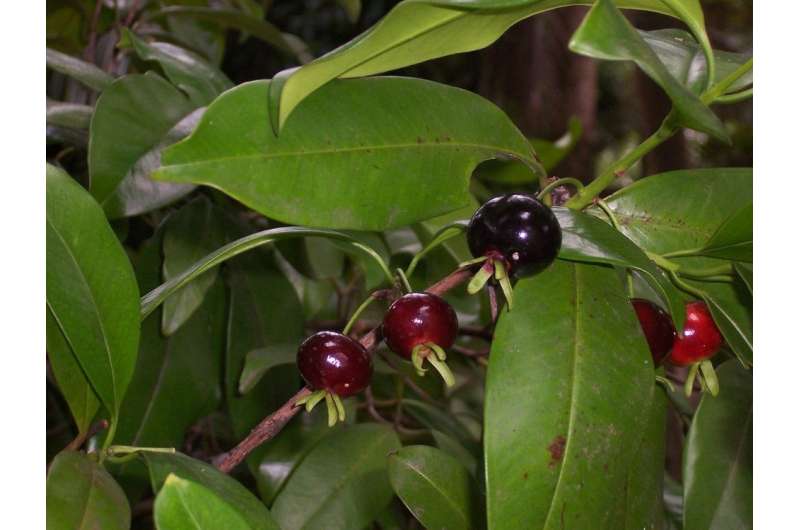Little-known fruits contain powerful anti-inflammatory and anti-oxidant agents

According to a study supported by the São Paulo Research Foundation, five fruit trees native to the Atlantic Rainforest have powerful antioxidant and anti-inflammatory properties.
The research finds that native Brazilian species araçá-piranga (E. leitonii), cereja-do-rio-grande (E. involucrata), grumixama (E. brasiliensis) e ubajaí (E. myrcianthes), all from genus Eugenia and bacupari-mirim (Garcinia brasiliensis) are examples of functional foods. Besides vitamins and nutrients, they have bioactive properties such as the capacity to combat free radicals, unstable, highly reactive atoms that bind to other atoms in the organism and cause damage including cellular aging and disease.
Severino Matias Alencar of São Paulo's Luiz de Queiroz Agricultural College (ESALQ-USP) says, "We knew they could contain a large number of antioxidants, just like the well-known berries of the US and Europe, such as the blueberry, blackberry, and strawberry, with which scientists are so familiar. Our native berries proved [to be] even better."
Pedro Rosalen, from FOP, says that diet is strategic in combating free radicals. Although our body contains substances that neutralize and eliminate free radicals, this natural neutralization can be unbalanced by age, stress and poor alimentation. "If so, exogenous elements are required, particularly the intake of foods with antioxidant agents such as flavonoids or anthocyanins from araçá-piranga, E. leitonii, and other fruits of the Eugenias," said Rosalen.
Antioxidants fight aging, but they also prevent diseases mediated by chronic inflammation, explains Rosalen. "The oxidative action of free radicals leads to the appearance of dependent inflammatory diseases, such as diabetes, cancer, arthritis, obesity and Alzheimer's. These are silent inflammations, hence the importance of antioxidants."
The study evaluated phenolic compounds—chemicals that can have preventive or curative effects—and the anti-inflammatory and antioxidant mechanisms of material extracted from the five fruits' leaves, seeds, and pulp. The project studied fruits with strong antioxidant activity and anti-inflammatory properties. The standout was E. leitonii.
"E. leitonii is an endangered species," Rosalen said. "Its anti-inflammatory activity far exceeded that of other Eugenias. The mechanism is also extremely interesting. It occurs spontaneously and right at the start of inflammation, blocking a specific pathway in the inflammatory process. It also acts on the endothelium of blood vessels, preventing leukocytes from transmigrating to the damaged tissue and reducing exacerbation of the inflammatory process."
Because these species are increasingly rare and some are classified as endangered, the samples for the study were supplied by two small farms in the interior of São Paulo State. Both sell plants with conservational aims. One of the farmers owns Brazil's largest native fruit collection, with over 1,300 species under cultivation.
Rosalen adds that Brazil has some 400 Eugenias, including several endemic species. "We have an enormous number of native fruit trees with bioactive compounds that could benefit people's health. They should be studied," he said.
Alencar believes that it is only a matter of time until these fruits are marketed as fashionable foods. He states that they have a vast economic and pharmacological potential, evidenced not only by many scientific publications, but also by the trade in edible fruits, wood and essential oils, and their use as ornamental plants.
"There wasn't much scientific knowledge about the properties of these native fruits. The idea now, with the results of our study, is for them to be grown by family farmers, increase production scale and be taken up by retailers. Who knows? They could be the next açaí," said Alencar, referring to the commercial success of the Amazonian berry Euterpe oleracea, which has high amounts of antioxidants. Brazil exports açaí puree to several countries.
The collaborative research project supported by FAPESP and UFRO also extended knowledge of a Chilean native species. In one study, the researchers demonstrated the antioxidant and vasodilatory action of Chilean guava (Ugni molinae)—food supplements obtained from the fruit and leaves of Chilean guava can have beneficial effects on the prevention and possibly treatment of cardiovascular diseases.
If knowledge of these properties is disseminated, the production of native fruit species could be stimulated, Alencar says. "Even before the project with UFRO, Rosalen and I already studied native fruit species because we believed they could be a source of excellent food solutions for society," he said.
More information: Juliana Infante et al. Antioxidant and Anti-Inflammatory Activities of Unexplored Brazilian Native Fruits, PLOS ONE (2016). DOI: 10.1371/journal.pone.0152974


















